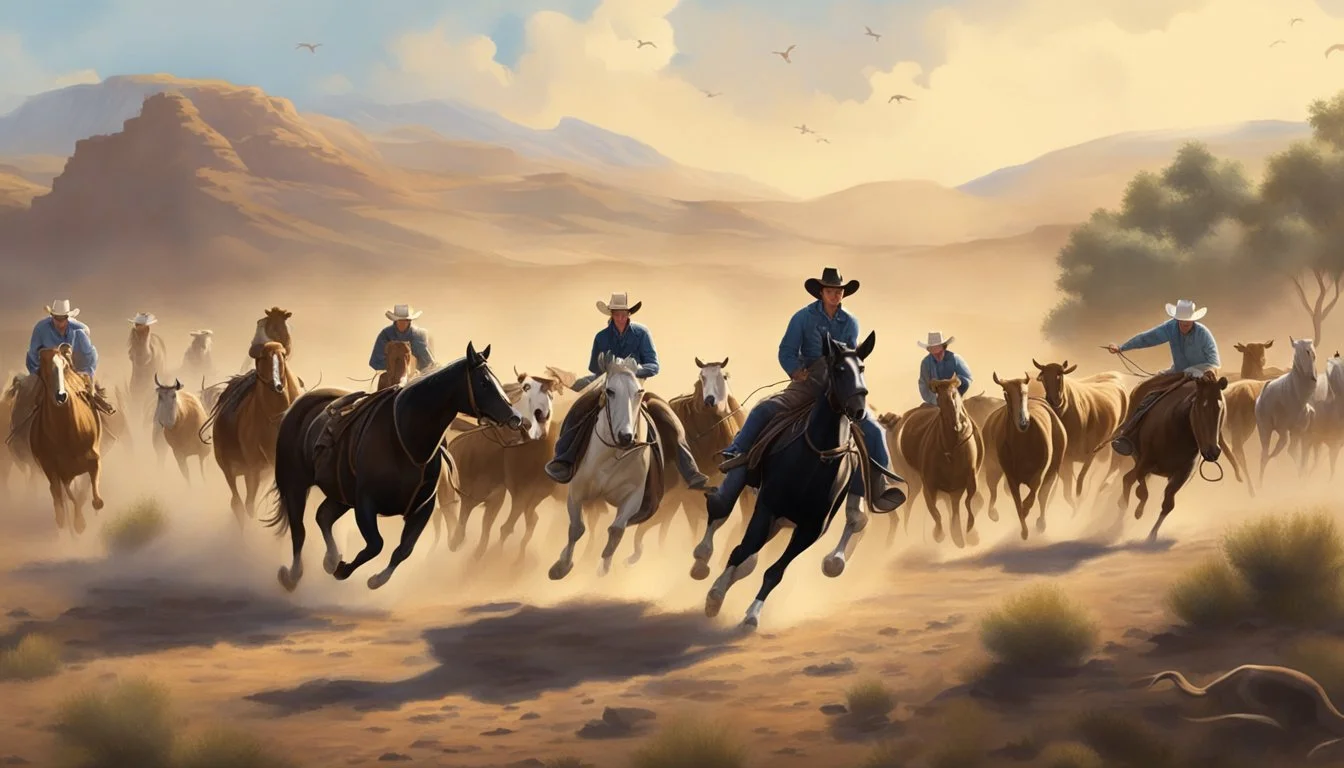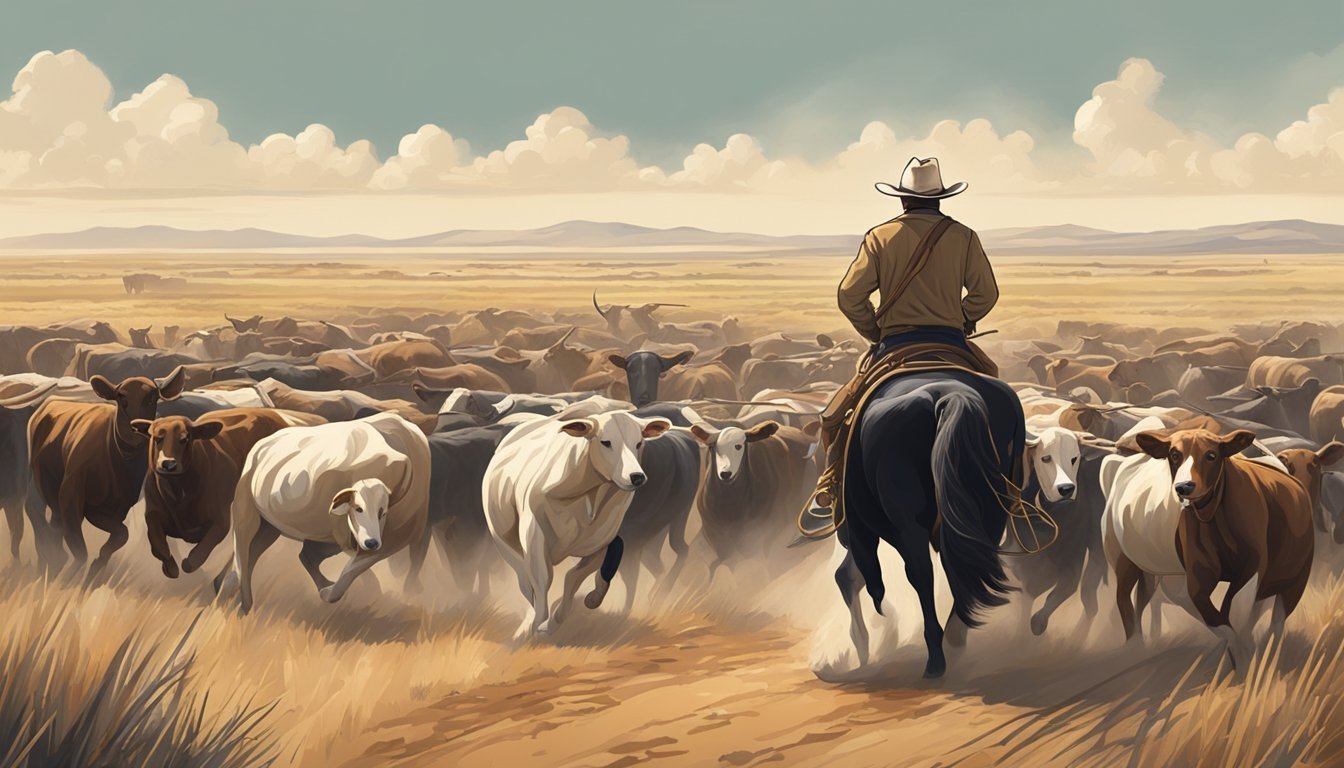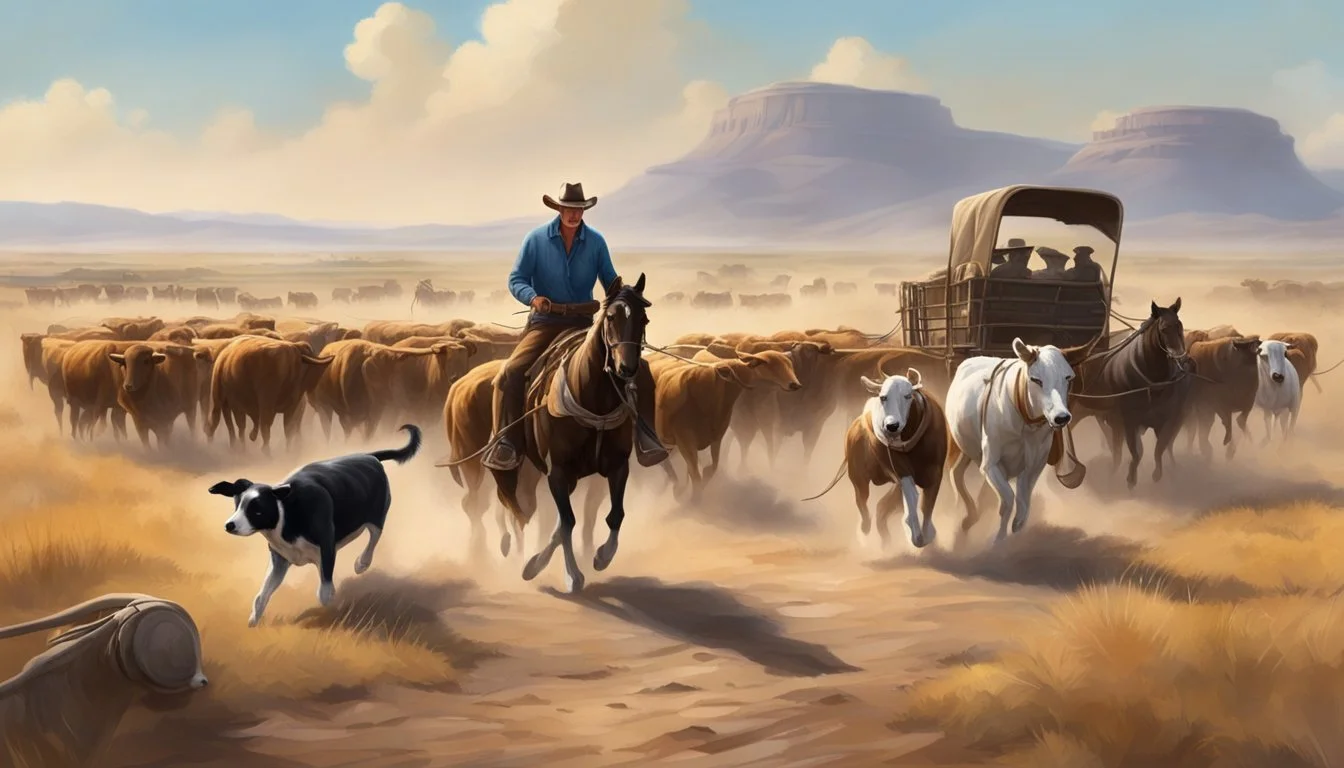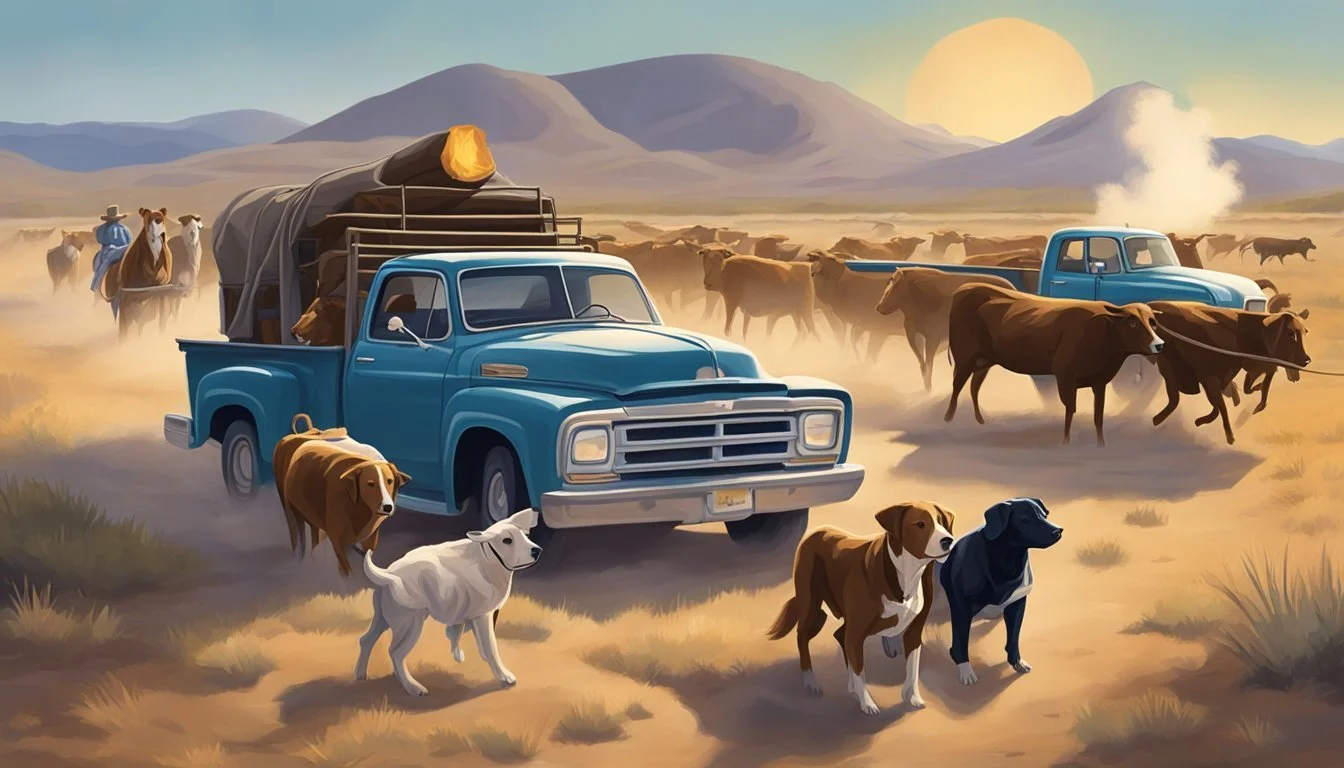The Role of Dogs in Ranch Life and Cowboy Culture
Canine Partners on the Prairie
In the rugged expanse of the American West, ranching has long been a pillar of both economy and culture. Cowboys, the quintessential symbols of this region, are known for their resilience and independence. Integral to their day-to-day operations, dogs have played a pivotal role not only as companions but also as invaluable working assets on the ranch. These canine partners, trained for specific tasks, have often made the workload manageable, allowing one cowboy to perform the work that would normally require several hands.
The cowboy and his dog, an iconic duo, illustrate a partnership that stretches back to the early days of ranching. Dogs are trained to herd livestock, a skill that reduces the need for additional labor, thus embodying efficiency and cooperation on the ranch. A well-trained dog can easily handle several hundred cattle, a testament to their impact on the operation's success. The breeds favored by ranchers, such as the Hangin' Tree cowdog, exemplify traits such as intelligence, responsiveness, and stamina, which are essential for the demands of ranch work.
These animals are not just utility partners but also a part of the cowboy's family, reflecting a deep-seated affection and mutual respect. Collectively, the cowboy and ranch dog epitomize the spirited connection between humans, animals, and the land - a connection that continues to resonate throughout American West cowboy culture. Their ongoing presence on the ranch reaffirms that the romanticized figure of the cowboy, far from being a relic of the past, remains a living, breathing element of the modern American narrative.
Historical Context
The role of dogs in the American West's ranch life is deeply intertwined with the evolution of cowboy culture and livestock management practices established during the settlement and expansion of the 19th century.
Origins of Cowboy Culture
The rise of cowboy culture is an American narrative that took significant shape in Texas during the early 19th century. It melded Spanish, Mexican, and Native American influences with Anglo traditions, notably evolving from the vaquero tradition of northern Mexico.
Influence of Spanish and Mexican Traditions
The Spanish introduced cattle and horses to the New World in the 16th century, laying the groundwork for ranching practices. By the 1700s, these practices were well-established in Mexican territories, including Texas, where they were further developed by both Spanish and Mexican ranchers and embodied by vaqueros.
Native Americans and the West
Native Americans of the Great Plains, like the Comanche, adapted to the introduction of horses and began managing large herds of their own. These interactions with settlers and their livestock were pivotal in shaping the ranching landscape of the American West.
Cattle Drives and the Open Range
In the mid-to-late 19th century, the iconic cattle drive epitomized cowboy life. Drovers, including cowboys and their dogs, drove thousands of cattle over long distances across the open range to railheads, steering the expansion of the American frontier.
19th Century Ranching and Settlement
The settlement of the West in the late 19th century transformed cowboy culture from a nomadic lifestyle to a more stationary one, with ranchers and their workers, including American cowboys, transitioning to large-scale operations that cultivated the Western image of ranching as we know it today. Dogs were pivotal in these operations, aiding in the control and protection of herds.
Ranch Life
Ranch life demands a high level of skill and endurance from ranchers as they engage in day-to-day tasks that are crucial for managing a successful ranching operation. Dogs play a significant role in ranch operations, working alongside humans and horses to manage livestock.
The Rancher's Daily Tasks
The daily routine of a rancher starts before sunrise and involves a multitude of tasks such as feeding and caring for animals, repairing fences, and monitoring the health and well-being of the livestock. These tasks require a profound knowledge of animal behavior and a commitment to the land and its creatures.
Roles of Dogs in Ranch Operations
Dogs, especially breeds like the Australian shepherd and the Hangin' Tree cowdog, provide invaluable assistance on ranches. They are trained to herd cattle, often taking on responsibilities that would require several ranch hands. A single well-trained dog can significantly reduce the labor needed to handle hundreds of cattle.
Horse and Cattle Management
Horses are the rancher's partner in effectively managing cattle. They are essential for transportation across the ranch and are used in various tasks such as cattle round-ups and checking the perimeter. Horses aid in maneuvering livestock with precision, which is essential during activities like roping and steer wrestling.
Livestock Branding and Rodeo Origins
Branding is a heritage practice for identifying cattle ownership and deterring theft. It involves marking livestock with a heated iron symbol. This tradition has given rise to competitive events in rodeo, where skills such as roping and steer wrestling celebrate the abilities necessary for ranch life and honor cowboy culture.
Ranch life centers on a deep connection with animals, both livestock and the working dogs and horses that form the backbone of day-to-day operations. The skills and traditions born from this way of life resonate deeply in the spirit of the American West.
Cowboy and Rancher Culture
Cowboy and rancher culture is deeply embedded in American history, symbolizing the spirit of the Old West with its distinct attire, morality, and social events central to their community.
Symbols and Iconography
The cowboy life is replete with symbols that represent the hardworking and independent spirit of these custodians of the plains. Stetson hats and cowboy boots have become icons not just of the cowboy, but of American culture as a whole, symbolizing ruggedness and resilience. The saddle, an indispensable element for horse riding, is also a central icon, often ornately decorated and cared for with pride.
Clothing and Gear
Clothing and gear are as much about function as they are about tradition and identity in cowboy culture. Chaps and sombreros are worn to protect ranchers from brush and the sun, while Stetsons are considered almost a badge of honor, reflecting their status and role. Boots, designed with a high top and heels, aid in horse riding. This attire, developed out of necessity, has evolved into a recognized uniform for those in the culture.
Item Purpose Symbolic Value Chaps Leg protection Hard work, rugged terrain Saddle Horse riding tool Connection to the land Stetson Sun protection, status symbol Independence, Western spirit Boots Footwear for riding Function and tradition
Music, Dance, and Festivities
Music and dance are integral parts of cowboy festivities, typically featuring genres such as country and western. These celebrations are often community-centric, with gatherings such as rodeos showcasing cowboy skills. They foster a sense of camaraderie and tradition through line dancing and ballads that tell stories of cowboy life and the pursuit of justice on the open range.
Cowboy Ethics and Values
Cowboys are often associated with a particular set of ethics and values, including hard work, honesty, and justice. They are stewards of the land, with a strong sense of right and wrong, and a commitment to their community and way of life. This code of conduct resonates through cowboy culture, reinforcing the traditions and societal norms that have been passed down through generations.
Cowboy and Ranchers Dogs
Dogs have served as invaluable partners to cowboys and ranchers, providing help with herding, protection, and companionship. Their roles are specific and vital to the daily operations on a ranch.
Breeds and Training
Cowboys and ranchers often favor breeds like the Australian Shepherd, known for their intelligence, agility, and instinctive herding abilities. Training for these dogs centers on honing their natural skills to direct and control livestock. Ranchers commonly implement a regimen that combines obedience with specialized commands for herding.
Key Traits: intelligence, agility, responsiveness
Training Methods:
Obedience drills
Field work with livestock
Herding commands
Roles in Herding and Protection
These dogs are primarily engaged in herding tasks, often managing large groups of cattle with minimal human guidance. Their ability to read animals often makes one dog as effective as multiple human hands on the ranch. Additionally, these dogs serve a protective role, guarding the herd from predators and potential threats.
Herding:
Gathering cattle
Moving livestock between pastures
Protection:
Guarding livestock
Alerting to dangers
Dogs and Cowboy Companionship
Beyond work, dogs provide loyal companionship to cowboys. The strong bonds forged are a testament to the dogs' social nature and the time spent together on the ranch. They serve as both confidants and work partners, featuring prominently in the cultural fabric of ranch life.
Companionship Aspects:
Loyal and dedicated presence
Emotional support after long workdays
Economic Aspects
Ranch dogs are not only essential companions but also significant economic assets in the cattle ranching industry. Their ability to manage livestock reduces labor costs and enhances efficiency.
Cattle Ranching Industry
In cattle ranching, dogs are considered a cost-effective form of labor. For instance, single-handedly, a well-trained dog can perform the work equivalent to that of three human workers, thereby significantly reducing the need for additional hired hands which can save ranchers around $500 a day. This financial benefit is crucial, considering that managing several hundred cattle is both labor-intensive and expensive.
Impact of Railroads on Ranching
Railroads revolutionized the ranching industry by providing a means of transportation that connected cattle ranches to broader markets. The ability to move large numbers of cattle quickly and efficiently to slaughterhouses and markets not only boosted profits but also expanded the reach of ranching operations. Dogs played a part in this by ensuring cattle reached railheads in good condition, thereby fetching higher market prices.
Meat and Leather Markets
The output of ranch life, namely beef and hides, creates a direct link to the meat and leather markets. Efficient herding and protection of livestock by dogs ensure less stress on the animals, which is known to affect the quality of both meat and leather. The work of ranch dogs helps safeguard these commodities until they can be transported via railroads to markets, maximizing the return on investment for ranchers.
Cultural Representation
Dogs have been prominent symbols in the cultural representation of ranch life and cowboy culture, often appearing alongside cowboys in various forms of media and public exhibitions. They are not only part of daily ranch activities but also serve as icons within the narrative of the American West.
Cowboy Archetype in Film and Literature
In film and literature, the cowboy is frequently portrayed as a rugged, independent figure, with loyal dogs by his side emphasizing the themes of companionship and trust. Cinematic depictions show dogs herding cattle, protecting their owners, and contributing to the day-to-day duties on the range. Likewise, in literature, cowboys and their canine companions are often central to the storytelling, with poetry of the West further romanticizing their bond.
Rodeos as Cultural Exhibitions
Rodeos serve as cultural exhibitions, showcasing the skills of both cowboys and their dogs. These events provide a window into the working relationship between a cowboy and his dog, demonstrating herding and obedience amidst a competitive and festive atmosphere. Audience members gain insight into the practical aspects of ranch work, which is a core part of cowboy culture.
Influence on Popular Culture
In popular culture, the image of the cowboy and his dog has influenced fashion, music, and general lifestyle. Clothing lines often use the cowboy aesthetic, incorporating elements associated with western life. Music, especially country, frequently includes references to the loyal dogs of cowboys, underscoring the cultural significance of these animals within the tapestry of Americana.
Evolution and Current State
The evolution of ranch life has witnessed significant shifts, with technological innovations greatly changing the role of dogs and the practice of ranching. At the same time, ranchers confront a reduction of traditional methods and face a myriad of contemporary challenges.
Technological Advancements in Ranching
Technological advancements have transformed ranch operations, enhancing efficiency and productivity. GPS tracking and drones are now used for monitoring vast tracts of land and livestock, complementing the herding functions traditionally performed by ranch dogs. The use of automated feeding systems reduces labor requirements. Livestock management software aids in health tracking, breeding, and grazing management.
The Decline of Traditional Practices
Amidst technological progression, there has been a noticeable decline in traditional ranching practices. Skills passed down through generations, such as roping and lassoing, are less utilized in modern ranching. This shift has affected dogs' roles as well, with their physical presence for herding and protection no longer as critical as it once was. Historical knowledge and the cultural idiosyncrasies of ranching are at risk of being lost.
Contemporary Challenges Faced by Ranchers
Ranchers today grapple with several challenges. There's a need to balance the use of new technologies with the preservation of traditional practices. Compounding this are economic pressures, with many ranches fighting to stay profitable amidst market fluctuations. Issues of discrimination and lack of diversity also persist within the ranching community, hindering its modernization and cultural evolution. Environmental concerns, such as land degradation and climate change, pose additional obstacles, making sustainability a critical goal for the future of ranching.






